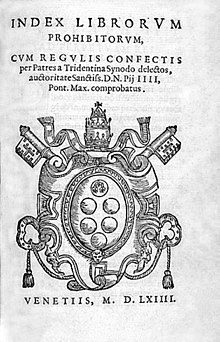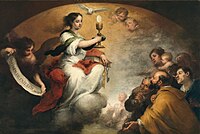
| Part of a series on |
| Catholic Counter-Reformation |
|---|
 |
| Catholic Reformation and Revival |
The Index Librorum Prohibitorum (English: Index of Forbidden Books) was a changing list of publications deemed heretical or contrary to morality by the Sacred Congregation of the Index (a former Dicastery of the Roman Curia); Catholics were forbidden to print or read them, subject to the local bishop.[1] Catholic states could enact laws to adapt or adopt the list and enforce it.
The Index was active from 1560 to 1966.[2][3][4][page needed] It banned thousands of book titles and blacklisted publications, including the works of Europe's intellectual elites.[5][6][7]
The Index condemned religious and secular texts alike, grading works by the degree to which they were deemed to be repugnant or dangerous to the church at the time.[8] The aim of the list was to protect church members from reading theologically, culturally, or politically disruptive books. At times such books included works by saints, such as theologian Robert Bellarmine[9] and philosopher Antonio Rosmini-Serbati,[10] astronomers, such as Johannes Kepler's Epitome astronomiae Copernicanae (published in three volumes from 1618 to 1621), which was on the Index from 1621 to 1835; works by philosophers, such as Immanuel Kant's Critique of Pure Reason (1781); and editions and translations of the Bible that had not been approved. Editions of the Index also contained the rules of the Church relating to the reading, selling, and preemptive censorship of books.[11]
- ^ Grendler, Paul F. "Printing and censorship" in The Cambridge History of Renaissance Philosophy, Charles B. Schmitt, ed. (Cambridge University Press, 1988, ISBN 978-0-52139748-3) pp. 45–46
- ^ The 20th and final edition of the Index appeared in 1948; the Index was formally abolished on 14 June 1966 by Pope Paul VI. "Notification regarding the abolition of the Index of books". 14 June 1966.
- ^ The Church in the Modern Age, (Volume 10) by Hubert Jedin, John Dolan, Gabriel Adriányi 1981 ISBN 082450013X, p. 168
- ^ Kusukawa, Sachiko (1999). "Galileo and Books". Starry Messenger.
- ^ Lenard, Max (2006). "On the origin, development and demise of the Index librorum prohibitorum". Journal of Access Services. 3 (4): 51–63. doi:10.1300/J204v03n04_05. S2CID 144325885.
- ^ Anastaplo, George. "Censorship". Encyclopedia Britannica. Retrieved 5 April 2022.
- ^ Hilgers, Joseph (1908). "Censorship of Books". The Catholic Encyclopedia. Vol. 3. Robert Appleton Company. Retrieved 5 April 2022.
- ^ Lyons, Martyns (2011). A Living History. Los Angeles. pp. Chapter 2.
{{cite book}}: CS1 maint: location missing publisher (link) - ^ Giannini, Massimo Carlo. "Robert Bellarmine: Jesuit, Intellectual, Saint". Pontifical Gregorian University. Retrieved 30 August 2023.
- ^ "Cardinal Saraiva calls new blessed Antonio Rosmini "giant of the culture"". Catholic News Agency.
- ^ Index Librorum Prohibitorum, 1559, Regula Quarta ("Rule 4")